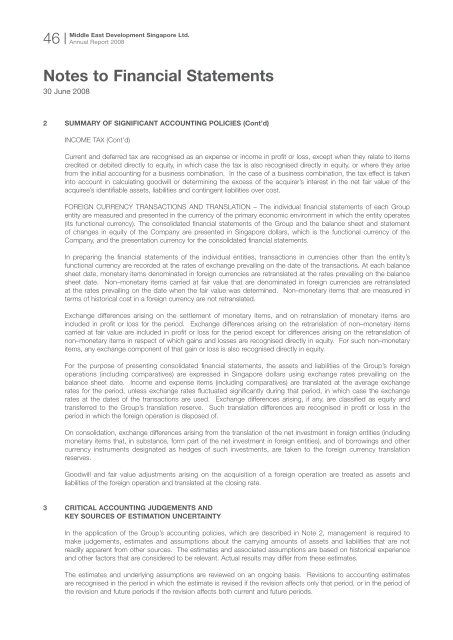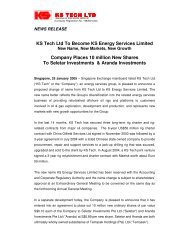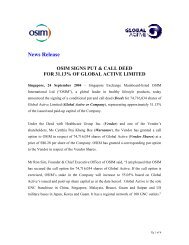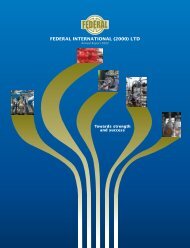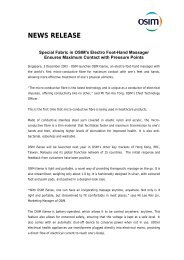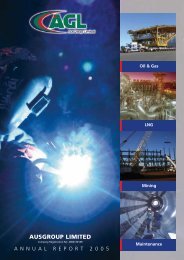Notes to Financial Statements
Notes to Financial Statements
Notes to Financial Statements
- No tags were found...
Create successful ePaper yourself
Turn your PDF publications into a flip-book with our unique Google optimized e-Paper software.
46Middle East Development Singapore Ltd.Annual Report 2008<strong>Notes</strong> <strong>to</strong> <strong>Financial</strong> <strong>Statements</strong>30 June 20082 SUMMARY OF SIGNIFICANT ACCOUNTING POLICIES (Cont’d)INCOME TAX (Cont’d)Current and deferred tax are recognised as an expense or income in profi t or loss, except when they relate <strong>to</strong> itemscredited or debited directly <strong>to</strong> equity, in which case the tax is also recognised directly in equity, or where they arisefrom the initial accounting for a business combination. In the case of a business combination, the tax effect is takenin<strong>to</strong> account in calculating goodwill or determining the excess of the acquirer’s interest in the net fair value of theacquiree’s identifi able assets, liabilities and contingent liabilities over cost.FOREIGN CURRENCY TRANSACTIONS AND TRANSLATION – The individual fi nancial statements of each Groupentity are measured and presented in the currency of the primary economic environment in which the entity operates(its functional currency). The consolidated fi nancial statements of the Group and the balance sheet and statemen<strong>to</strong>f changes in equity of the Company are presented in Singapore dollars, which is the functional currency of theCompany, and the presentation currency for the consolidated fi nancial statements.In preparing the fi nancial statements of the individual entities, transactions in currencies other than the entity’sfunctional currency are recorded at the rates of exchange prevailing on the date of the transactions. At each balancesheet date, monetary items denominated in foreign currencies are retranslated at the rates prevailing on the balancesheet date. Non–monetary items carried at fair value that are denominated in foreign currencies are retranslatedat the rates prevailing on the date when the fair value was determined. Non–monetary items that are measured interms of his<strong>to</strong>rical cost in a foreign currency are not retranslated.Exchange differences arising on the settlement of monetary items, and on retranslation of monetary items areincluded in profi t or loss for the period. Exchange differences arising on the retranslation of non–monetary itemscarried at fair value are included in profi t or loss for the period except for differences arising on the retranslation ofnon–monetary items in respect of which gains and losses are recognised directly in equity. For such non–monetaryitems, any exchange component of that gain or loss is also recognised directly in equity.For the purpose of presenting consolidated fi nancial statements, the assets and liabilities of the Group’s foreignoperations (including comparatives) are expressed in Singapore dollars using exchange rates prevailing on thebalance sheet date. Income and expense items (including comparatives) are translated at the average exchangerates for the period, unless exchange rates fl uctuated signifi cantly during that period, in which case the exchangerates at the dates of the transactions are used. Exchange differences arising, if any, are classifi ed as equity andtransferred <strong>to</strong> the Group’s translation reserve. Such translation differences are recognised in profi t or loss in theperiod in which the foreign operation is disposed of.On consolidation, exchange differences arising from the translation of the net investment in foreign entities (includingmonetary items that, in substance, form part of the net investment in foreign entities), and of borrowings and othercurrency instruments designated as hedges of such investments, are taken <strong>to</strong> the foreign currency translationreserves.Goodwill and fair value adjustments arising on the acquisition of a foreign operation are treated as assets andliabilities of the foreign operation and translated at the closing rate.3 CRITICAL ACCOUNTING JUDGEMENTS ANDKEY SOURCES OF ESTIMATION UNCERTAINTYIn the application of the Group’s accounting policies, which are described in Note 2, management is required <strong>to</strong>make judgements, estimates and assumptions about the carrying amounts of assets and liabilities that are notreadily apparent from other sources. The estimates and associated assumptions are based on his<strong>to</strong>rical experienceand other fac<strong>to</strong>rs that are considered <strong>to</strong> be relevant. Actual results may differ from these estimates.The estimates and underlying assumptions are reviewed on an ongoing basis. Revisions <strong>to</strong> accounting estimatesare recognised in the period in which the estimate is revised if the revision affects only that period, or in the period ofthe revision and future periods if the revision affects both current and future periods.


